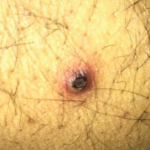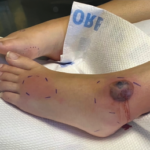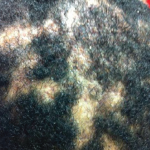Within this series, AA typically occurred in young adults and were in the spleen in the vast majority of cases (93%). Other involved areas included abdominal lymph nodes (48%), the liver (40%), lung (17%), pancreas (7%) and brain (2%). Most patients had fever (90%), as well as abdominal pain (67%) and weight loss (50%). Laboratory studies were non-specific, demonstrating leukocytosis in most patients (70%).2
In the cases in which an underlying condition could be identified, the condition was typically in the autoinflammatory spectrum of diseases (see Table 2, above). The majority (70%) of patients were ultimately diagnosed with IBD. Importantly, one-third of patients were diagnosed with IBD prior to the presentation of aseptic abscesses, one-third concurrently with IBD and one-third with a later diagnosis of IBD.2
Neutrophilic dermatoses, a heterogeneous group of inflammatory skin disorders characterized by a sterile dense infiltration of neutrophils in affected tissues (e.g., pyoderma gangrenosum), may exist on a continuum with AA.3 Supporting this observation, 20% of patients from the initial cohort were diagnosed with identifiable neutrophilic dermatoses.2,4
Further, neutrophilic dermatoses are well-described clinical manifestations of the autoinflammatory diseases associated with AA.3 Despite this clear association, it is important to note that the histopathologic features of AA and neutrophilic dermatoses are different—in AA, the abscesses can be surrounded by granulomatous reaction, which is atypical in neutrophilic dermatoses.2
One should have a strong suspicion for AA in a patient with abscesses that do not appropriately respond to antibiotic therapy, particularly in the setting of an autoinflammatory syndrome and/or neutrophilic dermatosis. In a patient with a suspected AA, one should thoroughly evaluate for an infectious process.
All patients should have blood cultures, as well as appropriate cultures of the abscess (including AFB and fungal). Consideration should also be made for testing for HIV or Tropheryma whipplei in patients with lymphadenopathy, arthralgias, gastrointestinal symptoms or weight loss.4 Given the high prevalence of associated (often occult) IBD, evaluation for IBD should be completed in all patients.
Treatment guidelines for AA do not exist, but first-line treatment typically consists of high-dose glucocorticoids (0.5–1 mg/kg). Given the high rate of recurrence, steroid-sparing agents are frequently trialed. A 2019 literature review detailed the use of multiple agents, including disease-modifying anti-
rheumatic drugs (e.g., most typically azathioprine, but also methotrexate, cyclosporine and mycophenolate), colchicine and biologic therapy (e.g., typically tumor necrosis factor [TNF] inhibitors, but also agents that block interleukin [IL] 1 and IL-6). Of these agents, TNF inhibitors had high rates of complete clinical responses and would generally be considered the initial treatment of choice.5
Table 2: Systemic Diseases Seen in Association with Aseptic Abscesses
| Systemic Disease | Key Clinical Features |
|---|---|
| Inflammatory bowel disease (IBD) | • Characterized by inflammatory changes of the GI tract |
| Synovitis, acne, pustulosis, hyperostosis, osteitis (SAPHO) | • Skin lesions include palmoplantar psoriasis and nodular acne • Neutrophilic dermatoses can be seen as part of the disease process • Osteitis most commonly involves the anterior chest wall, sacroiliac joint or spine |
| Chronic recurrent multifocal osteomyelitis (CRMO)/chronic nonbacterial osteomyelitis | • Typical onset in childhood with unifocal or multifocal osteomyelitis involvement of bones, including the metaphysis of the long bones of the lower extremities (most common), as well as the pelvis, vertebrae, clavicle, long bone of upper extremities and mandible |
| Tumor necrosis factor receptor-associated periodic fever (TRAPs) | • Periodic fever syndrome with typical onset in childhood, characterized by episodes of fevers lasting five days to two weeks and occurring every five to six weeks. |
| Pyogenic arthritis, pyoderma gangrenosum and acne (PAPA) | • Autosomal dominant disorder typically with childhood onset, characterized by destructive arthritis, nodular acne and absence of fevers |
| Pyoderma gangrenosum, acne and hidradenitis suppurativa (PASH) | • Triad of multiple neutrophilic dermatoses including pyoderma gangrenosum, acne and hidradenitis suppurativa |
| Pyogenic arthritis, pyoderma gangrenosum, acne, suppurative hidradenitis (PAPASH) | • Characterized by arthritis and multiple skin lesions |
| Myelodysplastic syndrome | • Characterized by abnormal blood cell maturation of a cell line leading to cytopenia(s) |
| Behçet’s disease | • A variable vessel size vasculitis • The disease is characterized by recurrent oral and genital ulcers • This multisystem disorder can include eye, gastrointestinal, neurologic and vascular disease |
| Relapsing polychondritis | • Chronic inflammation of cartilaginous structures • Typically involves the ears, nose, eye, respiratory tract and joints |


